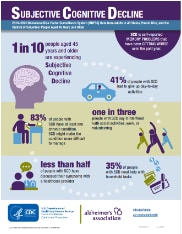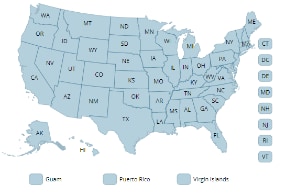Indicator Definitions – Cognitive Health and Caregiving

Alzheimer’s disease is one of the leading causes of death in the United States. It involves parts of the brain that control thought, memory, and language. It begins with mild memory loss and can lead to losing the ability to carry on a conversation and respond to the environment. Memory problems are one of the first warning signs of Alzheimer’s disease and related dementias (ADRD). Subjective cognitive decline (SCD) is the self-reported experience of worsening or more frequent memory loss within the previous 12 months and an early indicator of possible future ADRD.
Given the anticipated growth of the older adult population, it is important to decrease the burden of dementia using various public health strategies. For example, a growing body of evidence has identified potential modifiable risk factors for ADRD, and addressing these factors can help delay onset or slow the progression of ADRD. Early detection of dementia can also facilitate early intervention, including building a care team, participating in support services and counseling, addressing other chronic conditions, and better managing medications. In addition, supporting dementia caregivers is critical. Although caregiving provides numerous benefits to caregivers and recipients, it can also negatively impact caregivers’ mental and physical health.
Visit Alzheimer’s Disease and Healthy Aging | CDC for more information about this condition.



